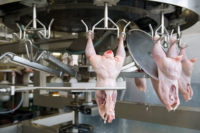USDA adds food safety requirements; new inspection system for poultry products

 In an effort to improve worker safety and prevent thousands of illnesses each year, USDA announced additional food safety requirements and the new National Poultry Inspection System (NPIS).
In an effort to improve worker safety and prevent thousands of illnesses each year, USDA announced additional food safety requirements and the new National Poultry Inspection System (NPIS).
Under the modernized rule, poultry companies will have to meet new requirements to control Salmonella and Campylobacter. In addition, the NPIS is an updated science-based inspection system that USDA says will better position food safety inspectors throughout poultry facilities.
“The US has been relying on a poultry inspection model that dates back to 1957, while rates of foodborne illness due to Salmonella and Campylobacter remain stubbornly high,” Said Tom Vilsack, USDA secretary. “The system we are announcing today imposes stricter requirements on the poultry industry and places our trained inspectors where they can better ensure food is being processed safely. These improvements make use of sound science to modernize food safety procedures and prevent thousands of illnesses each year.”
USDA’s Food Safety and Inspection Service will now require all poultry companies to take measures to prevent foodborne illnesses rather than address the contamination after it occurs.
For the first time, USDA said poultry facilities will be required to perform their own microbiological testing at two points in their production process to show that they are controlling Salmonella and Campylobacter.
The NPIS is optional. Under the system, poultry companies must sort their own product for defects before presenting it to inspectors, allowing inspectors to focus less time on tasks that have little to do with preventing pathogens and more time on food safety.
USDA says the maximum line speeds for plants using the NPIS will remain at 140 birds per minute, which is consistent with the maximum speed under current inspection programs.
The final rule can be read here.
Looking for a reprint of this article?
From high-res PDFs to custom plaques, order your copy today!




